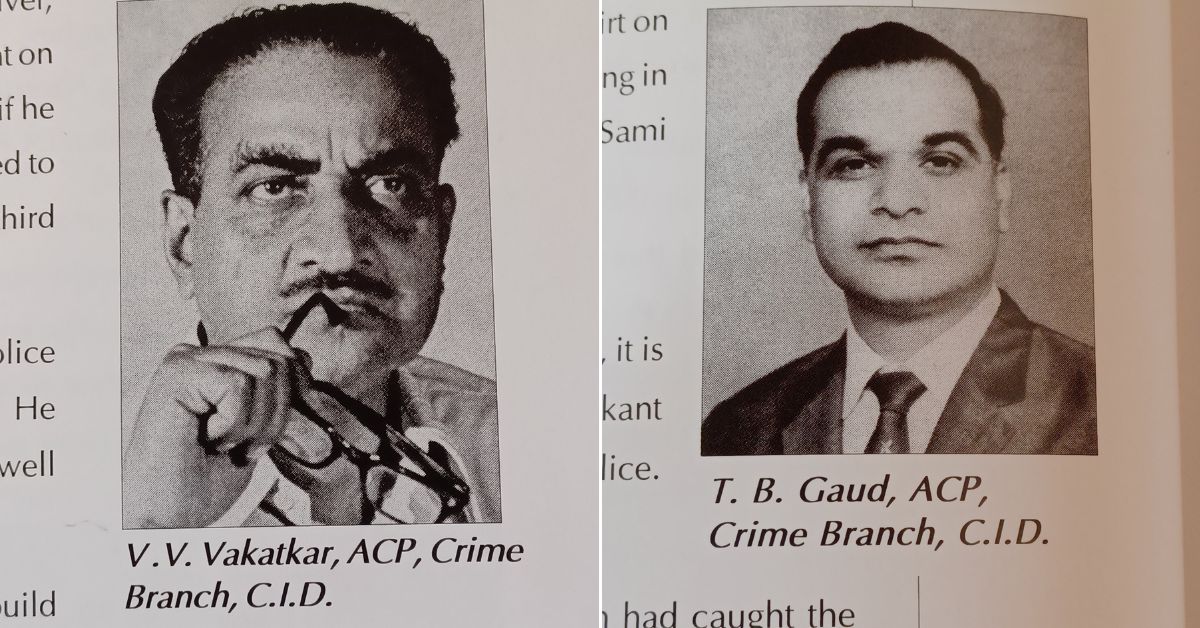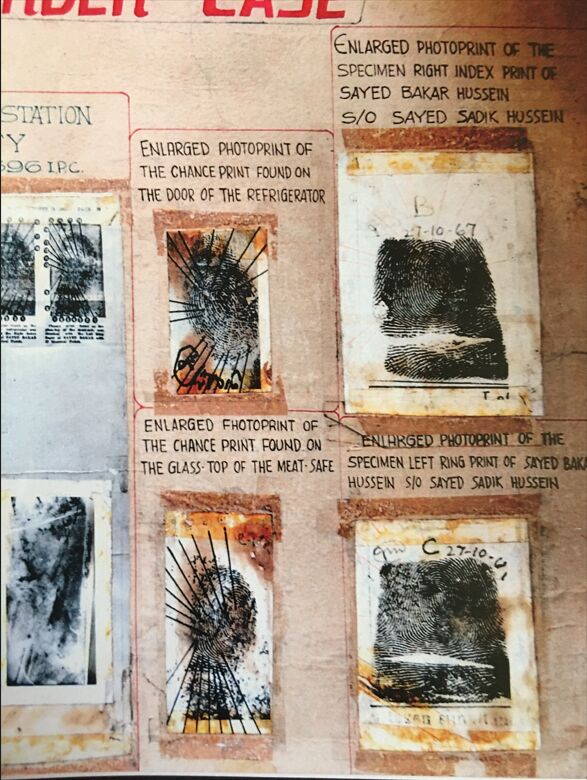Trigger Warning: Mentions of violence, murder
On the morning of 23 October, 1967, a milkman on his usual rounds came to deliver milk at the residence of Muhamed Siddique Choonawala — a local businessman and managing director of M/S Car Mart — at the ‘Temple View’ building on Hughes Road in Gamdevi, Bombay [Mumbai].
Despite knocking on his door many times, there was no response. Busy with his rounds, the milkman left the milk to a neighbour. After some time, Usman, the watchman of Choonawala’s M/S Car Mart, came to deliver milk bottles at his residence. Once again, he rang the bell but no response was forthcoming. Meanwhile, the cook Sayed Ahmed, who was sleeping in the common passage, woke up and saw smoke coming out of the windows of the flat.
As Mumbai-based journalist, author and local historian Dhaval Kulkarni notes in his recent thread on X (Twitter), “The main door of the flat was slightly ajar and he went in with Usman. They saw fire in the passage leading to the kitchen. This fire in newspapers and clothes was doused using buckets of water. Once the fire subsided, they were terrified to see human legs under the newspapers in a scorched condition. The watchman ran to the nearby Gamdevi police station and informed PSI (Police Sub-Inspector) Shivaji Deshmukh, who was on duty.”

What followed was a gory quadruple murder case, the first in the then Bombay, and a remarkable investigation led by Bombay Police [now Mumbai Police] CID deputy commissioner Vaidyanath Someshwar Sami, the father of legendary singer Usha Uthup.
Popularly known as the Bombay Police’s ‘Sherlock Holmes’, Vaidyanath Sami and his officers caught the culprits of his horrific crime using the laundry mark (tag) of burnt pieces of clothing found at the scene of this horrific crime.
Here’s how they solved this case.
Finding the laundry mark
Here’s how Dhaval describes the crime scene, “Deshmukh and his team rushed to the scene and observed that the gas pipe in the kitchen was loose. He hence went to the kitchen and closed the gas connection. He found four bodies in the flat with multiple stab wounds.”
“The bodies had been covered with newspapers and clothes, and it appeared that an attempt was made to set fire to the bodies and the flat as well by opening the gas pipe. The bedroom was ransacked, and cash and jewels were missing,” he goes on to add.
The victims were Choonawala, his wife Roshan, four-year-old grandson Shajitkhan [ also spelled Sajid Khan], and their house help Annie Fernandes. All four of the victims were stabbed to death.
According to The Queen of Indian Pop: The Authorised Biography of Usha Uthup — written by Vikram Kumar Jha and translated by Srishti Jha, “[Mohammad Siddiqui] Chunawala was a big businessman and his murder had put the Gamdevi Police Station in a deep shock. Curfew was enforced in the area under the police station’s jurisdiction. Ultimately, seeing no developments in this puzzling murder case, the inspector of the Gamdevi Police Station called [DCP] Vaidyanath Sami and communicated the gravity of the situation. He requested the latter to help in the investigation.” [*both the ‘Choonawala’ and ‘Chunawala‘ spellings have been used to describe the businessman murdered in this case*]
Following this request, DCP Vaidyanath dispatched his officers to the scene.
The evidence:
— Dhaval Kulkarni (धवल कुलकर्णी) 🇮🇳 (@dhavalkulkarni) January 10, 2024
Soon, officers of the Mumbai Police CID-Crime or the Crime branch like inspector Vinayak Vakatkar, and sub-inspectors Tatyasaheb Goud and Ramchandra Dudhat arrived at the scene. They came to know that on the previous day, Choonawala had returned home from Radio Club… pic.twitter.com/zQjVJqsQzd
Vinayak Vakatkar was a legendary officer in the Bombay Police crime branch. His cases and investigations made it to the newspapers and the works of local crime writers. Vakatkar eventually retired as an assistant commissioner of police. PSI Tatyasaheb Gaud retired as an ACP. An ace investigator with the Bombay Police, he was also a prolific writer in Marathi.

In establishing the sequence of events preceding the murder, they found that on the day of the murder, Choonawala had come back from the Radio Club at Colaba with his wife and grandson around 9 pm, and about half an hour later, they had their dinner. However, as they were scanning the crime scene, the officers found something that caught their attention.
As Dhaval explains, “The officers found a blood-stained shirt under the bed. It had the laundry mark AI Z with some letters before Z being cut. Another cloth found in the flat had the AI SBH laundry mark. However, all the other clothes found in the house had the J MSC laundry mark, making it evident that the shirt and cloth belonged to the assailants.”
“Some fingerprints were also detected on surfaces like the refrigerator in the dining hall. A blood-stained knife was also found. However, the fingerprints did not tally with those of the deceased or with the criminals in the records of the police,” he adds.
Catching the culprits
After discovering the pieces of clothes found at the crime scene, Inspector Vakatkar located 12 laundries in the city which used this laundry mark. On 24 October, the police finally zeroed in on the American Express laundry at Khetwadi and located its proprietor Shenolikar.
He promptly told the PSIs Goud and Dudhat that the ‘AI SBH’ and ‘AI Z’ laundry marks belonged to his laundry, and the two male customers whom they belonged to stayed in the same locality.
The arrests:
— Dhaval Kulkarni (धवल कुलकर्णी) 🇮🇳 (@dhavalkulkarni) January 10, 2024
On the same evening, the two accused Sayed Bakar Hussain and Sayed Ali Asad were arrested at Khetwadi back road. The two confessed to having committed the crime for pecuniary gain. They had stolen cash, gold and pearl ornaments and wrist watches worth Rs 10,000.… pic.twitter.com/b2jZQOQMCr
As Dhaval notes, “They had stolen cash, gold and pearl ornaments, and wristwatches worth Rs 10,000. Their fingerprints tallied with the chance prints found at the scene of the crime. They had discarded the blood-stained clothes and worn the washed clothes of Mr Choonawala.”
To solve any crime, however, the police need to establish a motive.
According to the police, Hussain was Choonawala’s driver and had been fired from his position. Hussain believed that Choonawala still owed him dues for working overtime, etc. Choonawala argued that all dues had been settled. During this argument, Hussain’s cousin Asad was also present. The argument with Choonawala escalated and soon the cousins committed the murder.
“They [cousins] later cut the dhobi mark from their blood-stained clothes to disguise their identity, set fire to clothes, newspapers, etc, and opened the gas connection,” explains Dhaval.
For their crimes, Hussain and Asad were sentenced to death by a principal sessions judge on 4 November 1968. In less than two weeks, the police had nabbed the culprits and a court found them guilty and sentenced them. This remarkable quadruple murder case was among the last cases of DCP Vaidyanath Sami’s illustrious career.

A brief note on DCP Vaidyanath Sami
During his tenure in the Bombay Police, which ran for more than three decades, DCP Vaidyanath Someshwar Sami solved many mysteries in ruthless criminal cases.
Interestingly, however, he had never imagined that he would join the police force.
Born on 21 November, 1908, in the then Bombay, Vaidyanath came from a rich lineage but humble beginnings. Although he was a descendent of Sir Kumarapuram Sheshadri Iyer, a long-time Dewan of Mysore, his father Someshwar Iyer worked for a long time at the Bombay Tram Company before moving to the then Mysore where he endured serious financial difficulties.
To support his family, Vaidyanath went to find work in Bombay after graduating from St Joseph’s College in Bengaluru. He worked odd jobs as a screen puller for the Opera House theatre and an insurance agent before he joined the police force in 1931.
The turning point in his career came in 1939 when he was made part of Bombay’s CID. This was done by senior officials in the police department who were impressed by “his attentive and dedicated work ethic”, according to the book Jha cited earlier in this article.

“He was associated with the Bombay Police’s crime branch for 28 years and retired as deputy commissioner towards the end of his career. His image in the Bombay Police was that of an impossible and, yet, intelligent officer,” notes Jha.
He was an investigative policeman in the truest sense. As Jha writes, “While researching a case, Sami would often visit the local tea shops and salons on street corners.”
“He believed that an investigation was like hunting with deep patience. One has to keep one’s sixth sense in a complete state of alertness. During the quest, he would also fully utilise Bombay Police’s Fingerprint Bureau and the Police Dog Squad. He placed informers in almost all the colonies in the then Bombay, He would only rest once he had enough evidence against the accused so that they wouldn’t get away in the court for the lack of it. However, he was against the practice of third-degree torture of criminals as he found it quite inhuman,” the book adds.
Throughout his career, he solved many high-profile cases including the Turf Soda Factory murder case, the then Bombay’s Central Bank robbery, Lloyd Bank robbery case, Kuldeep murder case, and the Bombay House robbery case, amongst others.
He would find clues from the most unexpected sources like in the Bombay Lloyds Bank robbery case, which he solved with the help of a clue given by a schoolgirl or an unclaimed car parked on Mohammad Ali Road in the then Bombay’s Central Bank robbery case.
He was truly a Sherlock Holmes of his time.
(Edited by Pranita Bhat)
Images courtesy Mumbai Police: Urbs Prima in Indis (Photos of the officers), Dhaval Kulkarni (Photos of the building) and Deepak Rao (Photos of the fingerprints, the Chunawala family and the two accused) and The Queen of Indian Pop: The Authorised Biography of Usha Uthup by Vikas Jha (Photo of Vaidyanath Someshwar Sami in a police uniform)
No comments:
Post a Comment